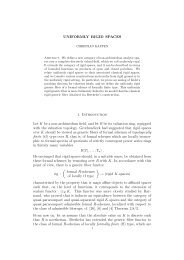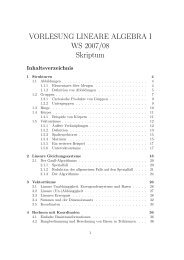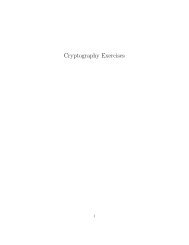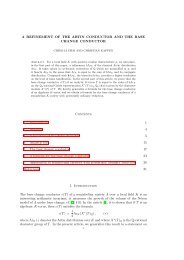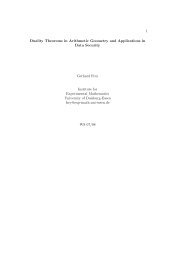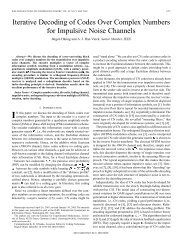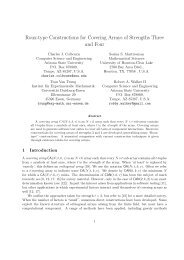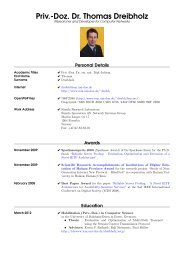Theorem 58 Let E/K be a <strong>CM</strong> <strong>elliptic</strong> curve, where K is an algebraically closedfield. If A ∼ E n is an abelian variety which is isogenous to E n , then there exist<strong>elliptic</strong> <strong>curves</strong> E 1 , . . . , E n ∼ E such that A ≃ E 1 × . . . × E n .Remark 59 In the case that K = C, Theorem 58 was first proven by Lange[19], usingthe results <strong>of</strong> Shioda and Mitani[24] (who proved the case n = 2). A different pro<strong>of</strong> <strong>of</strong>this was given by Schoen; cf. [22], Satz 2.4. His pro<strong>of</strong> is based on the above Theorem45(b) <strong>of</strong> Borevich and Faddeev[1] and hence is closely related to the one given below(in the case K = C).In his paper, Schoen[22] also proves the following interesting “converse” to Theorem58 in the case K = C. Suppose that A/C is an abelian variety with the property thatif B ∼ A, then B ≃ A 1 × . . . × A n , for some simple abelian varieties A i . Then eitherA is simple or A ∼ E n , where E/C is a <strong>CM</strong> <strong>elliptic</strong> curve.Before proving Theorem 58, let us see how Theorem 54 follows from it.Pro<strong>of</strong> <strong>of</strong> Theorem 54 (using Theorem 58). First note that the second equivalence<strong>of</strong> (97) is trivial because we have End(E) = Z(End(E n )) ⊂ E(H) ⇔ End(E) ⊂Z(E(H)) ⇔ f E(H) |f E .Next we note that the one direction (⇒) <strong>of</strong> the first equivalence <strong>of</strong> (97) is true byCorollary 11. It thus remains to prove the other direction.Thus, suppose that Z(End(E n )) ⊂ E(H). Since E is a <strong>CM</strong> <strong>elliptic</strong> curve, we havethat End(E n ) = End(E n ⊗ K), and hence also that End(A) = End(A ⊗ K). (Tosee this, note that End 0 (E n ) = End 0 (A) (because A ∼ E n ), and that End 0 (E n ) =End 0 (E n ⊗ K), and so the assertion follows because End(A ⊗ K)/End(A) is alwaystorsionfree.) Thus, we have that E(H ⊗ K) ≃ End(A ⊗ K) = End(A) ≃ E(H), and soZ(End(E n ⊗ K)) ⊂ Z(E(H ⊗ K)). Thus f AH⊗K = f E(H⊗K) |f E⊗K = f E .By Theorem 58 we have that A H⊗K ≃ E 1 ×. . .×E n , for some <strong>elliptic</strong> <strong>curves</strong> E i /K.By Corollary 53 we have f Ei |f AH⊗K |f E , and so E i ∈ Isog + (E ⊗K/K). Thus, condition(101) holds for H ⊗ K, and so H ⊗ K is an ideal subgroup <strong>of</strong> (E ⊗ K) n = E n ⊗ K byProposition 57. It thus follows from Remark 7(d) that H is an ideal subgroup <strong>of</strong> E n .Pro<strong>of</strong> <strong>of</strong> Theorem 58. We shall divide the pro<strong>of</strong> into several cases.Case 1. K = C.Here E ≃ E L , where L ∈ Lat F is a lattice in F = End 0 (E); cf. §3.2. Thus E n ≃ C n /L n ,where L n = L ⊕ . . . ⊕ L ⊂ F n . Let π : E n → A be an isogeny. Then Ker(π) = L ′ /L n ,for some subgroup L ′ ⊂ C n . Since [L ′ : L n ] = deg(π) < ∞, it follows that L ′ is a latticein F n (in particular, L ′ ⊂ F n ) and hence by Corollary 47 we know that L ′ has the form(91). Put L ′′ = L ′ 1 ⊕ . . . ⊕ L ′ n ⊂ F n , where L ′ i = R i for 1 ≤ i ≤ n − 1 and L ′ n = I andthe R i ’s and I are given by (91). Thus L ′ = L ′′ g, for some g ∈ Aut F (F n ) ⊂ Aut C (C n ),and so A ≃ C n /L ′ ≃ C n /L ′′ ≃ C/L ′ 1 ×. . .×C/L ′ n, and so the assertion follows becauseL ′ i ∈ Lat F (and hence C/L ′ i ∼ E L ).44
Case 2. char(K) = 0.As was mentioned in the pro<strong>of</strong> <strong>of</strong> Proposition 32, there is a <strong>CM</strong> <strong>elliptic</strong> curve E 0 /Qsuch that E 0 ⊗ K ≃ E. Furthermore, if π : E n → A is an isogeny with kernel H, thenthere is a subgroup scheme H 0 <strong>of</strong> E0 n such that H 0 ⊗ K = H, and so A 0 = (E0 n ) H0 isan abelian variety over Q with A 0 ⊗ K ≃ A. It is thus enough to verify the assertionfor K = Q.Thus, let K = Q. By Case 1 we know that there exist <strong>CM</strong> <strong>elliptic</strong> <strong>curves</strong>E 1 , . . . , E n ∈ Isog(E ⊗ C/C) such that A ⊗ C ≃ E 1 × . . . × E n . As before, thereexist <strong>CM</strong> <strong>elliptic</strong> <strong>curves</strong> E i0 /K such that E i0 ⊗ C ≃ E i . Put A ′ = E 10 × . . . × E n0 .As was just mentioned, every finite group scheme <strong>of</strong> A ⊗ C is already defined over K,and so it follows that the condition A ⊗ C ∼ A ′ ⊗ C implies that A ∼ A ′ . This provesthe assertion in this case.Case 3. K = F p .Let K # denote the quotient field <strong>of</strong> the ring W (K) <strong>of</strong> Witt-vectors. For any ordinaryabelian variety A/K, its Serre-Tate lift A # /K # exists and is uniquely characterized bythe property that all endomorphisms <strong>of</strong> A/K lift to A # ; cf. [9], p. 238, or [13], p. 2368,and the references therein. Since E and hence A ∼ E n are ordinary abelian varieties,their Serre-Tate lifts exist; note that (E # ) n ≃ (E n ) # . Since Hom((E n ) # , A # ) =Hom(E n , A), it thus follows that A # ∼ (E # ) n . By Case 2 we know that there is a finiteextension K ′ /K # and <strong>elliptic</strong> <strong>curves</strong> E ′ 1, . . . , E ′ n/K ′ such that A # ⊗K ′ ≃ E ′ 1×. . .×E ′ n.Since each E ′ i ∼ E # ⊗ K ′ has good reduction E i /K, we obtain that A ≃ E 1 × . . . × E nbecause A is the reduction <strong>of</strong> A # ⊗ K ′ .Case 4. char(K) = p ≠ 0.This is partially similar to the pro<strong>of</strong> <strong>of</strong> Case 2, but extra care has to taken here indescending A. To be precise, note first that there is a <strong>CM</strong> <strong>elliptic</strong> curve E 0 /F p suchthat E 0 ⊗ K ≃ E; cf. the pro<strong>of</strong> <strong>of</strong> Proposition 32. Furthermore, if π : E n → A is anisogeny with kernel H, then by Lemma 60 below, there is a subgroup scheme H 0 <strong>of</strong>E n 0 such that H 0 ⊗ K = H, and so A 0 = (E n 0 ) H0 is an abelian variety over Q withA 0 ⊗ K ≃ A. By Case 3 there exist E 1 , . . . , E n ∼ E 0 such that A 0 ≃ E 1 × . . . × E n ,and then A ≃ A 0 ⊗ K ≃ E ′ 1 × . . . × E ′ n, where E ′ i = E i ⊗ K ∼ E, as desired.In the above pro<strong>of</strong> we made use <strong>of</strong> the following fact.Lemma 60 Let E/K be a <strong>CM</strong> <strong>elliptic</strong> curve where K is an algebraically closed field,and let n ≥ 1. Then E n has only finitely many subgroup schemes H <strong>of</strong> fixed rank N.Thus, if K ′ /K is any extension field, then every finite subgroup scheme <strong>of</strong> E n ⊗ K ′ is<strong>of</strong> the form H ⊗ K ′ , where H is a finite subgroup scheme <strong>of</strong> E n .Pro<strong>of</strong>. If char(K) = 0, then every finite subgroup scheme is etale and the assertion istrivial. Thus, assume that char(K) = p ≠ 0. Since E is ordinary, we have for any r ≥ 1that E[p r ] := Ker([p r ] E ) ≃ Z/p r Z × µ p r, and hence that E n [p r ] ≃ (Z/p r Z) n × (µ p r) n .45
- Page 1: Products of CM elliptic curves1 Int
- Page 7 and 8: Indeed, if If is a kernel ideal, th
- Page 9 and 10: Indeed, by (18) we have I 1 f = I 2
- Page 11 and 12: Proof. To prove (29), let h ∈ Hom
- Page 13 and 14: 2.4 The quadratic caseWe now specia
- Page 15 and 16: ecause here f 2 |f 1 , so f = f 2 a
- Page 17 and 18: For this, put f = [R ′ : R], I =
- Page 19 and 20: From (54) we can conclude that(55)d
- Page 21 and 22: If H is any finite subgroup scheme
- Page 23 and 24: E. As we shall see, it is very illu
- Page 25 and 26: From this we see on the one hand th
- Page 27 and 28: Proposition 30 Let L ∈ Lat F , wh
- Page 29 and 30: (b) Deuring[10], p. 263. Note that
- Page 31 and 32: integral quadratic formq L,α,β (x
- Page 33 and 34: Corollary 39 Let E 1 /K and E 2 /K
- Page 35 and 36: Proof. Write π i = π Hi : A → A
- Page 37 and 38: (a) The order R is cyclic if and on
- Page 39 and 40: for k = 1, . . . , n − 2. Moreove
- Page 41 and 42: 4.3 Products of CM elliptic curvesW
- Page 43: Corollary 56 Let E/K be a CM ellipt
- Page 47 and 48: Let h A/K (X) ∈ Z[X] (respectivel
- Page 49 and 50: Proof. To prove this, we shall use
- Page 51 and 52: where xy denotes the quadratic form
- Page 53 and 54: denote the set of isomorphism class



